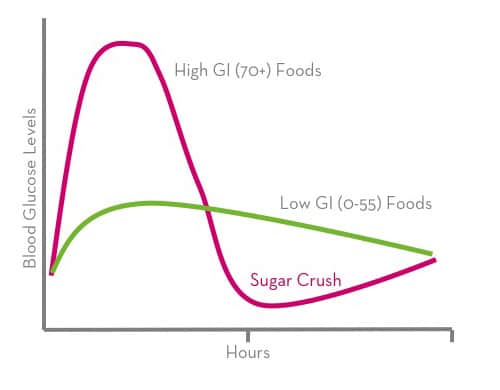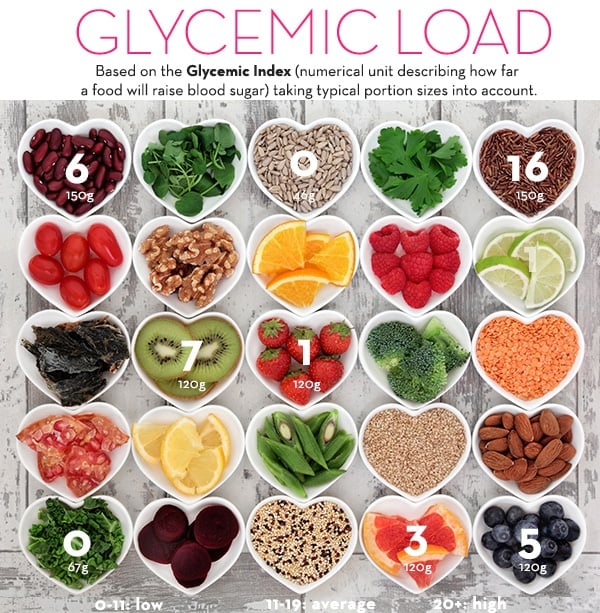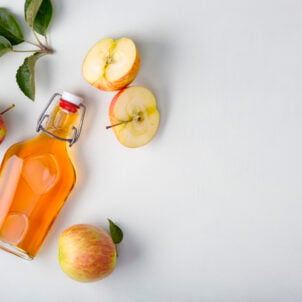As an early-80s baby, I clearly remember the nutrition dogma that guided our family’s eating habits. Fat was bad while sugar-free, fat-free everything ruled our pantry. A bagel with no-fat cream cheese and jam was considered to be healthier than a vegetable and egg scramble. Like most of the country, we knew that fat was an evil nutrient that led to many chronic diseases.
Fast-forward 30 years, and nutrition science has evolved significantly. While fats should still be consumed in moderation, there’s greater understanding of the importance of healthy fats. Next, more caution is given to the various forms of carbohydrates. That’s why the best way to lose weight is to understand more about how certain nutrients affect our bodies.
 For instance, 100 percent stone-ground whole-wheat bread has a lower GI number than rye or pita bread. Therefore, the latter will be metabolized more slowly than the whole-wheat bread. These low-GI foods help with satiation since they likely contain fiber, fat, and/or protein, which aid in feeling fullness. So, eating a lower-GI food should keep you satisfied for longer.
Frequent consumption of high-glycemic index foods results in a faster increase in blood glucose levels followed by a quick descent. We know this best as a sugar crash, the quick energy boost from eating something with a high GI, followed by a loss of energy and hypoglycemia (low blood sugar levels).
For sustained energy, eating low-GI foods is best. With these, the blood sugar response is more gradual and creates less demand on insulin. While the GI can be really helpful, it isn’t always exact. How you prepare the food, what it’s eaten with, and how ripe the food is can all affect GI levels.
For instance, a Snickers bar is much lower than watermelon on the GI scale. However, I don’t think anyone ever gained weight eating too much watermelon! Therefore, I advise clients to use the GI scale as a starting point, not a line in the sand to determine food quality. Don’t forget other factors like calories, fiber, vitamins, and minerals.
For instance, 100 percent stone-ground whole-wheat bread has a lower GI number than rye or pita bread. Therefore, the latter will be metabolized more slowly than the whole-wheat bread. These low-GI foods help with satiation since they likely contain fiber, fat, and/or protein, which aid in feeling fullness. So, eating a lower-GI food should keep you satisfied for longer.
Frequent consumption of high-glycemic index foods results in a faster increase in blood glucose levels followed by a quick descent. We know this best as a sugar crash, the quick energy boost from eating something with a high GI, followed by a loss of energy and hypoglycemia (low blood sugar levels).
For sustained energy, eating low-GI foods is best. With these, the blood sugar response is more gradual and creates less demand on insulin. While the GI can be really helpful, it isn’t always exact. How you prepare the food, what it’s eaten with, and how ripe the food is can all affect GI levels.
For instance, a Snickers bar is much lower than watermelon on the GI scale. However, I don’t think anyone ever gained weight eating too much watermelon! Therefore, I advise clients to use the GI scale as a starting point, not a line in the sand to determine food quality. Don’t forget other factors like calories, fiber, vitamins, and minerals.
 When comparing GI to GL, I’m more concerned about the load, as it’s a better indicator of carbohydrate health. For the healthiest diet, focus more on whole grains, nuts, legumes, fruits, non-starchy vegetables. Steer clear of white breads, white rice, candy, soda, and sugar.
When comparing GI to GL, I’m more concerned about the load, as it’s a better indicator of carbohydrate health. For the healthiest diet, focus more on whole grains, nuts, legumes, fruits, non-starchy vegetables. Steer clear of white breads, white rice, candy, soda, and sugar.
Best Way to Lose Weight: Get to Know Carbohydrates
Essentially, carbohydrates are judged by how they affect blood sugar and the eminent insulin response. Whether you’re eating a cookie or oatmeal, the bodily reaction is somewhat similar. The carbohydrate is broken down in the stomach and then converted into glucose, your body’s preferred energy source. Glucose then enters the blood stream where blood glucose levels rise. Insulin is then released to allow cells to uptake glucose for energy use. In a very basic way, here’s how our cells use energy: We eat, break down our food into glucose, and then our cells use this glucose to fuel activities. Whether you’re shopping, running, or typing on your computer, your body needs glucose to survive.The Glycemic Index
To see the best way to lose weight, we can measure how a certain food affects blood sugar. To do this, we can look at the GI, or glycemic index. Foods are ranked based on how they compare to pure glucose. A food with a high GI number raises blood glucose levels more than a food with a medium or low GI. Glycemic Index charts, like this comprehensive chart from Harvard Health Publications, give you an idea about how fast your body converts the carbs in a food into glucose. Faster breakdown means an uptick in glucose levels, which can lead to being hungry more often as the levels come down. For instance, 100 percent stone-ground whole-wheat bread has a lower GI number than rye or pita bread. Therefore, the latter will be metabolized more slowly than the whole-wheat bread. These low-GI foods help with satiation since they likely contain fiber, fat, and/or protein, which aid in feeling fullness. So, eating a lower-GI food should keep you satisfied for longer.
Frequent consumption of high-glycemic index foods results in a faster increase in blood glucose levels followed by a quick descent. We know this best as a sugar crash, the quick energy boost from eating something with a high GI, followed by a loss of energy and hypoglycemia (low blood sugar levels).
For sustained energy, eating low-GI foods is best. With these, the blood sugar response is more gradual and creates less demand on insulin. While the GI can be really helpful, it isn’t always exact. How you prepare the food, what it’s eaten with, and how ripe the food is can all affect GI levels.
For instance, a Snickers bar is much lower than watermelon on the GI scale. However, I don’t think anyone ever gained weight eating too much watermelon! Therefore, I advise clients to use the GI scale as a starting point, not a line in the sand to determine food quality. Don’t forget other factors like calories, fiber, vitamins, and minerals.
For instance, 100 percent stone-ground whole-wheat bread has a lower GI number than rye or pita bread. Therefore, the latter will be metabolized more slowly than the whole-wheat bread. These low-GI foods help with satiation since they likely contain fiber, fat, and/or protein, which aid in feeling fullness. So, eating a lower-GI food should keep you satisfied for longer.
Frequent consumption of high-glycemic index foods results in a faster increase in blood glucose levels followed by a quick descent. We know this best as a sugar crash, the quick energy boost from eating something with a high GI, followed by a loss of energy and hypoglycemia (low blood sugar levels).
For sustained energy, eating low-GI foods is best. With these, the blood sugar response is more gradual and creates less demand on insulin. While the GI can be really helpful, it isn’t always exact. How you prepare the food, what it’s eaten with, and how ripe the food is can all affect GI levels.
For instance, a Snickers bar is much lower than watermelon on the GI scale. However, I don’t think anyone ever gained weight eating too much watermelon! Therefore, I advise clients to use the GI scale as a starting point, not a line in the sand to determine food quality. Don’t forget other factors like calories, fiber, vitamins, and minerals.
The Glycemic Load
The glycemic index is a great reference point when comparing two foods containing the same amounts of carbohydrates. However, most of us rarely eat just one carbohydrate-containing food at a meal. My oatmeal is likely going to have maple syrup and dried fruit in it as well, two foods with different GI levels. The glycemic load (GL) then is used to describe both the quality (GI) and the quantity of the carbohydrates in the diet. The glycemic load of a food is calculated by multiplying the glycemic index by the amount of carbohydrates of the food and then dividing by 100. When comparing GI to GL, I’m more concerned about the load, as it’s a better indicator of carbohydrate health. For the healthiest diet, focus more on whole grains, nuts, legumes, fruits, non-starchy vegetables. Steer clear of white breads, white rice, candy, soda, and sugar.
When comparing GI to GL, I’m more concerned about the load, as it’s a better indicator of carbohydrate health. For the healthiest diet, focus more on whole grains, nuts, legumes, fruits, non-starchy vegetables. Steer clear of white breads, white rice, candy, soda, and sugar.
Best Way to Lose Weight: Don’t Fear Fats
Using the GL is a nice way to make sure your meal is balanced and a reminder not to fear fat. When thinking about the GL to help with weight loss, it’s all about satiety. The more satisfied you feel, the less calories you need, and therefore weight loss is less of a pain. If I’m hungry all the time and limiting my intake, that’s going to be a struggle. If I’m full and eating fewer calories, I’m naturally losing weight but not feeling punished. This scenario poses a huge difference in the weight-loss experience! While you shouldn’t fear fat, it’s the most easily converted macronutrient into adipose tissue. It also has double the calories per gram than carbs or protein. I’ve seen plenty of clients think that fat is fine, only to gain a ton of weight when adding more into their diets.Best way to lose weight: Applying the GI
To demonstrate how understanding the glycemic load can help you make healthier decisions, let’s look at a simple stir fry using quinoa versus white rice Quinoa’s GL is 13 while white rice is 43. Just by switching the grains, you’re looking at a much lower GL in the former than in the latter. That’s because quinoa contains more protein and fiber, essentials in a lower GL number. Ideally, the quinoa stir fry will keep you satisfied for longer than the white-rice alternative, and won’t affect blood sugars the same way.Takeaways
- Make healthier decisions by understanding how maintaining low glucose levels helps sustain energy throughout your day and keep hunger levels from spiking.
- Low-GI foods often contain fiber, fat, and/or protein. Thus, eating low-GI foods can support your weight loss goals by helping you feel fuller, longer.
- The glycemic load (GL) can a better indicator of carb health than glycemic index (GI) because it takes the average serving size into account.
- Understanding the way glucose affects your body can be a great reminder to avoid overindulging in carbs and not to fear fats, especially healthy monounsaturated fats.
- For weight loss, getting to know how nutrients affect your body is an amazing tool. It’s important to remember that nutrient density, calorie count, and exercise all play huge roles in your health and weight. (Read more about this in our study on 45 habits for a smaller waist.)
Supplemental Support
For an extra support system optimizing nutrient absorption, HUM’s Flatter Me digestive enzymes are designed to optimize protein, carb, fiber, and fat breakdown. Within the comprehensive enzyme blend, lipase enzymes boost the breakdown of fatty lipid substances, papain breaks down tough protein fibers, amylase supports the body in digesting starches to support all phases of digestion, reduce bloating, and helps you achieve a slimmer stomach. In addition, for optimal digestive support we also recommend Gut Instinct. Our potent probiotic ensures nutrient absorption, boosts immunity, helps regulate digestion, and maintains your weight.More like this









